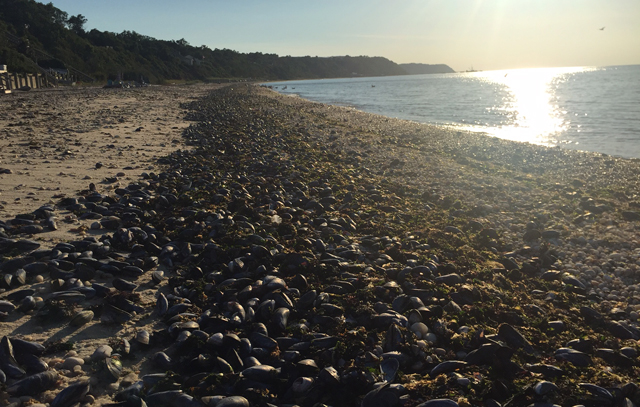Biologist: High temperatures may have caused mussel die-off


What caused thousands of blue mussels to appear along the shoreline in the Jamesport area this week hasn’t officially been determined. However, a local biologist believes the culprit may be rising water temperatures in the Long Island Sound.
“They’ve been hit with these consecutive heat waves that are just too hot for them,” said Christopher Gobler, the associate dean and researcher with the School of Marine and Atmospheric Sciences at Stony Brook.
State Department of Environmental Conservation officials concurred.
“It is likely that high water temperatures due to the prolonged hot temperatures we have experienced this summer is the cause,” DEC spokesperson Aphrodite Montalvo said.
The mussel die-off appeared Wednesday morning just east of Iron Pier beach and west of the oil terminal. Jamesport homeowner David Gruner said he and his wife noticed a rotting smell that morning and walked along the private beach to find thousands of mussels.
Mr. Gruner, a Jamesport native, said he’s never seen anything like the recent mussel die-off.
“It has created a whole nuisance here,” he said.
Mr. Gruner, who described the mussels as clean and adult-sized, speculates they were farm-raised. He believes they died while being transported by boat and were dumped overboard.
Mr. Gobler, however, described his theory as “not probable.”
“It’s awfully coincidental,” he said.
Mussels thrive when temperatures along the shoreline are around 70 degrees, Mr. Gobler said. Recently, shoreline water temperatures have hovered around 80 degrees, which he described as too warm for mussels to survive.
Mr. Gobler said he believes the mussels found in Jamesport were born in late 2013. The following two summers were cool, which may have helped the mussels grow but also made them less able to adapt when temperatures shot up this summer, he added.
Mr. Gobler also said he believes long-term climate trends show warmer ocean temperatures may be here to stay since satellite readings of ocean temperatures by the National Oceanic and Atmospheric Administration dating back to 1982 show rising ocean temperatures.
“Eastern Long Island Sound and the Peconic stand out as a region that’s already experienced more rapid warming than a lot of the rest of the region,” he said. “It’s already an area that’s warming quickly.”
The rising ocean temperatures coincide with increasing signs of global warming, Mr. Gobler added.
According to a recent NOAA’s climate report, this July was the Earth’s warmest month on record dating back to 1880. In addition, the report found 2016 has been the warmest year on record worldwide, which the agency described as an unprecedented trend.
Local authorities said they will be on the lookout for future mussel die-offs and algal blooms related to high ocean temperatures.
“As temperatures continue to increase due to climate change,” Ms. Montalvo explained, “the DEC will continue to monitor the effects of these changing temperatures on our local marine wildlife including shellfish and finfish.”
Photo: Many mussels had washed ashore toward United Riverhead Terminal. (Credit: Grant Parpan / Aug. 24, 2016).








